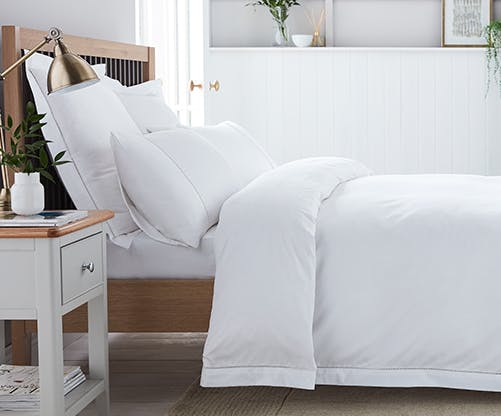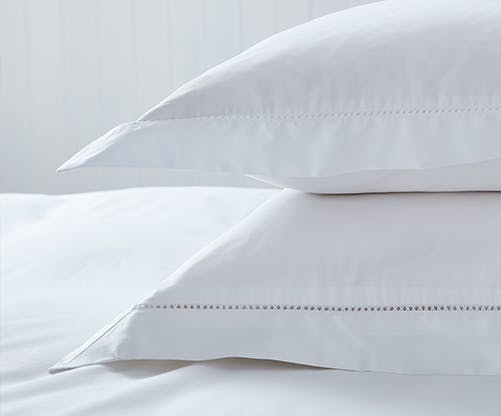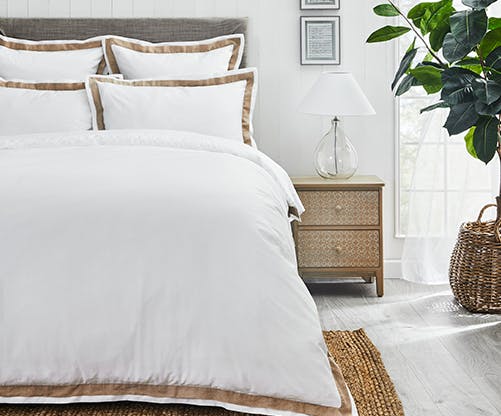How to Care for Your Purity Bedding
Getting into bed after a long day and sinking into luxuriously soft layers is a comfort for not only the body, but the mind as well. High quality bedding can be an investment that really pays off when it comes to soothing, restful sleep, and taking care of it properly means you will have those sumptuous options to hand for years to come! To get the best value from your investment, you’ll need to take good care of your bed linen, and we’ve made that easier with our best insider tips below.
How to wash white bedding
There is nothing quite like crisp white bed linen, so it’s worth taking a few extra steps to keep it bright and stain-free for longer.
- Remove all makeup before getting into bed to avoid products marking your pillowcases.
- Treat stains as soon as you can. Use a wet sponge and dish detergent or a stain spray, rub the liquid in until the mark is almost completely lifted, and pop the item straight in the washing machine to do the rest.
- Avoid your fabric yellowing by saying no to bleach. Try adding 59mls of lemon juice or 45g of baking powder in with your detergent to work on tough stains. For a little extra help, add 118ml of white vinegar just before the rinse cycle.
- Change your bedding regularly - once a week is ideal if you can. This will remove the build-up of natural oils, dead skin and sweat that can spoil the vibrancy of your sheets.
- Make sure you’re separating your whites when it comes to wash day to avoid them picking up dye residues from other items and looking dull.
- Line dry when possible. Gentle drying is always best, so it’s a gloriously sunny day, get your newly washed bedding out in the fresh air, and if that’s not an option try tumble drying on low.
How to whiten yellow pillows
Over time, pillows can yellow due to moisture, makeup, and a build-up of oils. You could simply replace them, but if the pillow itself is still in good condition there are a few helpful tips to renew them.
- Spot treat any stains with baking soda and water to help loosen them before washing the pillow according to its care instructions.
- If your pillow can be machine washed, use a mixture of vinegar, baking soda and detergent before running a follow up rinse cycle.
- If you opt to hand wash, clean stains with baking soda and a toothbrush and allow to dry out in the sun.
- Make sure you’re keeping your pillowcase inserts fresh by cleaning them twice a year.
Make it smell amazing
Inhaling the comforting smell of fresh linen is all part of the joy of changing your bedding and getting into it every day! To keep your sheets smelling their best, try to include the following tips into your routine.
- Wash your bedding regularly and make sure it’s completely dry before using it (don’t forget to give your duvet and pillows a couple of washes throughout the year too).
- Air your bedding daily by folding back the duvet and blankets. If you can, let your mattress breathe between bed linen changes.
- Use a lightly fragranced fabric softener or try a fabric spray for an instantly refreshed feel.
- Try out DIY dryer sheets by putting a few drops of your favourite essential oil onto a clean, damp cloth. Pop it into your dryer with your bedding for the last 10 minutes of the cycle.
Removing pet hair
We all love our furry friends, however their hair attaches very easily to any fabrics, including your bedding whether their visit is fleeting or they join you all night. . Thankfully there are some easy solutions to removing them.
- Give your bedding a good shake outside to remove as much loose hair as you can.
- Run a lint roller, piece of sticky tape or a damp rubber glove over the surface of the fabric.
- If you have a tumble dryer, put everything in with a couple of dryer sheets to pick up the extra hair.
- If you haven’t got a dryer, simply clean your linens as usual in the washing machine then give it another good shake once it has dried.
Sustainable ways to dry bedding indoors
Drying bed linen without a tumble dryer when the weather isn’t very nice can be tricky, but there are sustainable indoor options that will do the job nicely.
- For smaller pieces such as your pillowcases, use radiators (making sure they aren’t too hot) or your regular indoor airer.
- Depending on the weather, open a window or door and place your airer near it so natural ventilation speeds up drying.
- To help with an even drying experience, rotate your bedding throughout the day and focus damper patches towards the heat of the radiator or natural ventilation.
- P.S. Don’t leave your wet bedding in a basket for long. Not only does this increase the chances of it smelling musky, it also means creasing are going to cling. Use an indoor airer, stair banister or open door to drape each piece over, making sure to pull out any folds and wrinkles.
How to make bedding really soft
No one wants scratchy and stiff bedding, so to keep your linens soft and supple to the touch, here are a few ideas to get you started.
- On a cold or warm wash, use 230g of baking soda without detergent or softener. Add 237ml of vinegar during the final cycle with a cold water setting and then re-wash your bedding a second time with half the amount of detergent usually used. This helps to strip away chemicals that make your bedding feel unpleasant to the touch.
- Dry your bedding in the sun when possible as this helps to soften the fibres.
- Add 188mls of white vinegar to your wash cycle alongside detergent for extra fresh, soft sheets.
Wash your bedding inserts
Did you know you should wash your pillow inserts (by which we mean pillows and duvets) every 6 months to keep them clean and fresh?? Since they’re in close contact with your skin every time you use them, they need an occasional refresh to get rid of any dust, residual oils and skin cells.
- Use pillow protectors and duvet protectors to keep the filling safe and free from damage, and wash them with a mild liquid detergent (to avoid powder residue).
- To ensure that the detergent is washed away, put them onto a rinse cycle afterwards.
- Use a tumble dryer on a no-heat or low-heat setting to get plumped up and ready to be placed back on your bed.
Replacing pillows and duvets
If you treat your bedding correctly with regular cleaning and plumping, you could find that your pillows and duvet offer you cosy comfort for years. With a feather filled pillow lasting around 10-15 years and other synthetic options, around 3-4. If you find that your pillow is starting to look sad despite being plumped and fluffed or you’re waking with a painful neck, it’s time to look for a replacement. There are plenty of options to find your perfect match depending on what support you need to help get that perfect night’s sleep.
Storage tips
To give your bedding the longest life possible and help you enjoy a luxurious result every-time, how you store it can help or hinder its longevity.
- Store matching sets in one of the pillowcases to make sure all of the pieces stay together neatly.
- …Or you could sort and organise your bedding by type so it’s easily accessible and allows for easy rotation of use.
- If you are placing bedding on a shelf, place a liner on the surface first to avoid any marks, stains or splinters from damaging the fabric.
- Fabric bags or vacuum bags are great for storing spare or out of season bedding.
- If you have different sized beds in the house, you can use labelled boxes so it’s easy for everyone to find their bedding.
Use scented sachets in your linen cupboard to keep things fresh and avoid musky storage smells.





